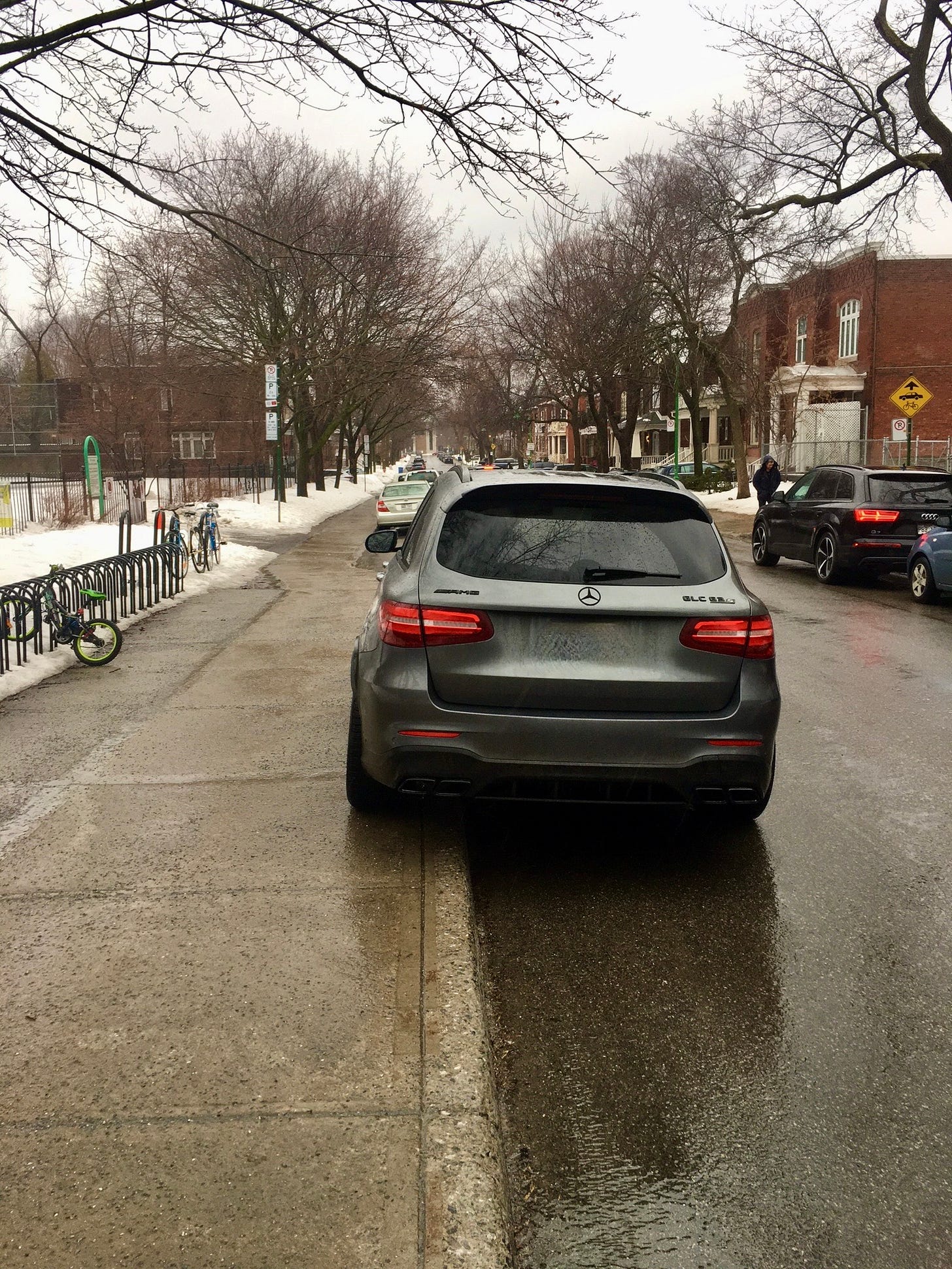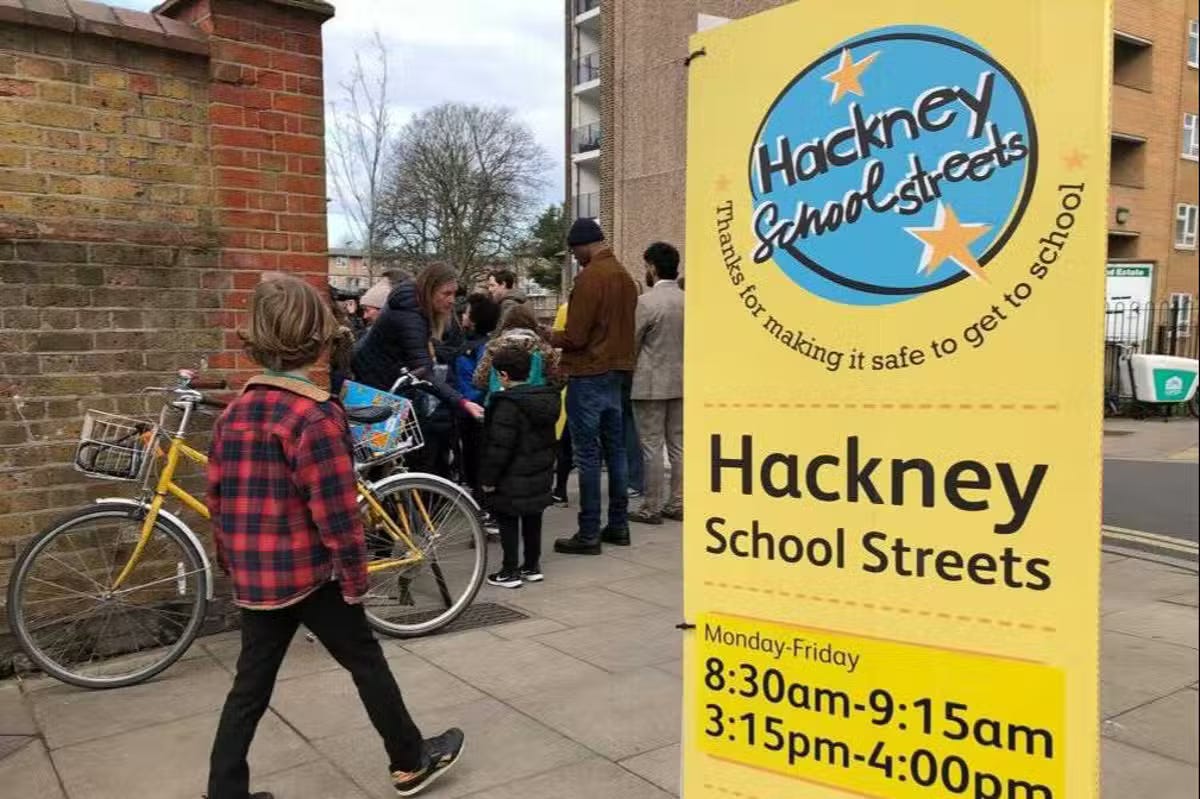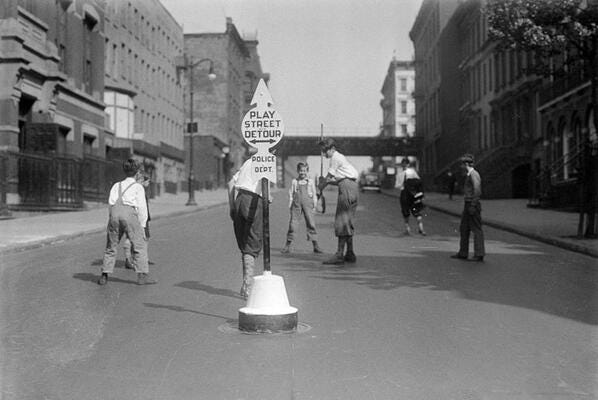The Case for Car-free "School Streets"
Europe has them, and they save kids' lives. It's time we brought them to North America.
Every weekday of the school year, my two boys, who are seven and eleven years old, run a life-threatening, and—for a parent—terrifying, gauntlet. We don’t own a car, and live about five blocks away from their school. (The two facts aren’t unconnected: we’ve given a lot of thought to the geometry of our daily lives, but that’s another story.) That means they walk or ride their bicycles year ’round, like I did when I was a kid. In spite of the fact that our neighborhood is one of the most walkable in Montreal, and possibly all of Canada, a large number of parents chauffeur their children to school in cars, pick-ups, SUVs, and mini-vans.
It’s especially intense at 8:25 in the morning, when parents-in-a-hurry are dropping their kids off. My boys are still young enough that my wife or I walk or bike alongside them every day. And, over the last several years, we’ve seen some nasty things.

Parents parking on the sidewalk. Idling in the crosswalks. Flinging doors open too quickly. Pulling away from the curb, and nearly taking out kids on bikes, who sometimes ride down the one-way street in the direction opposite from the permitted traffic “flow.” Many drivers seem to want “rock star” parking, and jostle for space as close to the schoolyard entrance as they can possibly get. I’ve come to think of it as our daily rodeo, and I’ve trained our kids to dismount from their bikes as they approach school, use the crosswalks, and obey the (overworked) crossing guard. There have been near-misses—I’ve personally witnessed at least a dozen. Late last year, Maria Legenkovska, a 7-year-old girl, was killed by a hit-and-run driver in another borough of Montreal, as she was walking to school. She was a refugee, and had arrived in Canada from Ukraine two months earlier.
Over the last few years, it’s been my fondest hope that Montreal would embrace a movement that’s spreading through Europe: “School Streets,” as they’re known in England, or “Rue aux Écoles,” as they call them in France.1 Paris now has 180 of them; cars are either completely banned, or are prevented from approaching, through the use of movable barriers, during the times kids are arriving at or leaving school. In London alone, there are now 300 School Streets. One study2 showed that 81% of parents and teachers are satisfied with the measures, there’s been a 23% decrease in emissions, and—this is crucial—one in five parents reported driving their kids to school less because of the change.
There are historical precedents for this. In the twentieth century, the UK had 700 “Play Streets” where the road was closed to all “mechanically propelled vehicles,” allowing kids to get outside and be kids, without fear of being crushed.
They weren’t limited to Europe. New York had its own play streets, supervised by the police department, which let children escape tenements, get outside, and enjoy a game of kick the can or stickball: here’s one from Manhattan, in 1916.
Makes all kind of sense, when you think about it. In crowded cities, precious public space, the streets outside our houses and apartments, shouldn’t necessarily be used for warehousing private automobiles, or hurrying the drivers of those automobiles along their way. But nobody thinks that way any more, at least not on this side of the Atlantic. We’ve all come to accept the idea that roads were built for cars (and they most definitely were not: as Carlton Reid has shown in his book Roads Were Not Built For Cars, most urban roads were first paved in the late 19th century after intense lobbying by bicycle riders).3
What boggles my smog-addled mind is that it’s seen as a radical proposition that streets outside our kids’ schools should be closed, at least for part of the day, to traffic. How can this even be controversial? Cars outside schools are a major source of PM2.5 particles, which have a severe impact on kids’ respiratory health. Cars, especially supersized pick-ups with enormous blind spots, are a manifest danger to children’s lives. And relying on cars for the school run sets a terrible example. We need to be encouraging walking, cycling, and other forms of active transport, rather than strapping SUVs to our kids’ asses.
If any city in North America should be an early adopter of the “School Street” idea, it’s Montreal. People here use transit—more, by some measures, than any other major city in North America. We have some pretty fantastic bicycle infrastructure, even if too much of it is still paint on pavement. The central city is eminently walkable. And we have a mayor in city hall, Valérie Plante, whose party, Projet Montréal, has made it a mission to make the city greener and more bicycle- and pedestrian-friendly. Yet the few tentative attempts at limiting car use around schools have run into huge opposition, and, where they have been instituted, they are nowhere near as well thought-out or safe as those in Europe.
It’s bizarre. We are a society obsessed with the safety of our children, sometimes to a ridiculous extent. Yet when it comes to the school run, the automobile remains sacred. At our kids’ school, we’re trying to change that. The obstacles we’re running into are frustrating, but also illuminating. Especially when it comes to our societal disconnect between talking green, but never actually getting around to walking the walk.
I’ll be sharing more about our struggles to make our kids’ lives safer in the weeks to come.

In the meantime, I hope you’ll consider becoming a paid subscriber to my Straphanger Substack. Almost everybody who’s signed up so far is a “free rider.” There’s no shame in that. But to keep the faith, and to keep up the writing, I’m going to need at least a few people who are willing to help out by chipping in, even with a low-priced monthly subscription.
https://www.paris.fr/pages/57-nouvelles-rues-aux-ecoles-dans-paris-8197
https://www.london.gov.uk/press-releases/mayoral/school-streets-improve-air-quality
https://roadswerenotbuiltforcars.com/







